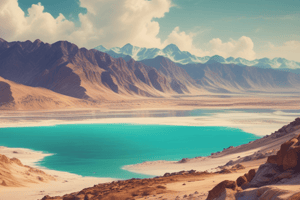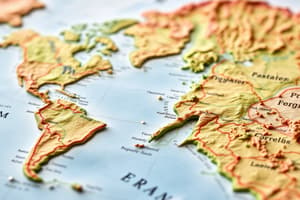Podcast
Questions and Answers
What is Mesopotamia often called and why?
What is Mesopotamia often called and why?
Mesopotamia is often called the cradle of civilization because it is believed that the earliest civilizations first arose there.
Give an example of how geography determined where civilizations developed.
Give an example of how geography determined where civilizations developed.
An example is the ancient Egyptians who lived in the Nile River Valley.
How did the Hittite civilization prosper?
How did the Hittite civilization prosper?
The Hittite civilization prospered partly because of their reliance on the natural resource of iron.
How did the Incas overcome geography and climate?
How did the Incas overcome geography and climate?
What is the role of geography and climate in affecting culture?
What is the role of geography and climate in affecting culture?
Give an example of a cultural difference based on geography and climate mentioned in the text.
Give an example of a cultural difference based on geography and climate mentioned in the text.
How do geography and climate impact the location of civilizations?
How do geography and climate impact the location of civilizations?
What are some examples of cultural adaptations related to geography?
What are some examples of cultural adaptations related to geography?
How can geography and climate shape the overall look of a civilization?
How can geography and climate shape the overall look of a civilization?
What factors contributed to the rise of civilizations in certain regions?
What factors contributed to the rise of civilizations in certain regions?
What role did river systems play in the development of early civilizations?
What role did river systems play in the development of early civilizations?
How did civilizations adapt to their specific geography and climate?
How did civilizations adapt to their specific geography and climate?
What was the significance of the Neolithic Revolution in human history?
What was the significance of the Neolithic Revolution in human history?
How did geography and climate affect minor aspects of life in civilizations?
How did geography and climate affect minor aspects of life in civilizations?
Flashcards
Cradle of Civilization
Cradle of Civilization
The place where the earliest known civilizations developed.
Geography & Civilization
Geography & Civilization
Geographic factors (like water sources, resources) influence where civilizations arise.
Hittites & Iron
Hittites & Iron
The Hittites used iron, helping their civilization's success.
Incas & Machu Picchu
Incas & Machu Picchu
Signup and view all the flashcards
Geography & Culture
Geography & Culture
Signup and view all the flashcards
Hockey & Climate
Hockey & Climate
Signup and view all the flashcards
Civilization Location
Civilization Location
Signup and view all the flashcards
Adaptation to Geography
Adaptation to Geography
Signup and view all the flashcards
Civilization's Look
Civilization's Look
Signup and view all the flashcards
Rise of Civilizations
Rise of Civilizations
Signup and view all the flashcards
Rivers & Civilizations
Rivers & Civilizations
Signup and view all the flashcards
Technological Adaptation
Technological Adaptation
Signup and view all the flashcards
Neolithic Revolution
Neolithic Revolution
Signup and view all the flashcards
Minor Impacts
Minor Impacts
Signup and view all the flashcards




